The Impact of Hybridization on Island-Type Renewable Energy Systems
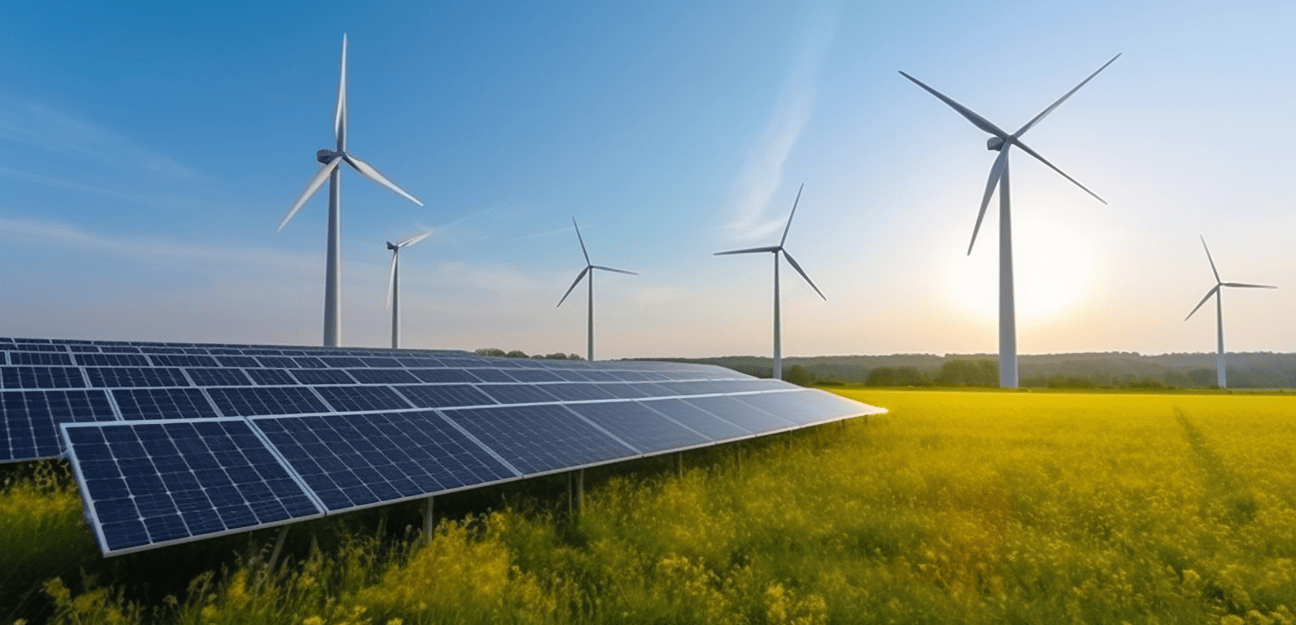
By Jorge Olmedo González, Rosa de Guadalupe González Huerta
National Polytechnic Institute-ESIQIE, UPALM, Mexico City, Mexico
rgonzalezh@ipn-mx
Introduction
Humanity's technological development has fostered a significant dependence on electricity, making a reliable, high-quality supply a basic necessity. According to data from the Federal Electricity Commission (CFE), approximately 99% of the Mexican population has access to electricity, but nearly 36% live in conditions of energy poverty, meaning they have low-quality or intermittent service. This is due, among other factors, to the fact that many of these people live in remote, hard-to-reach areas. Some alternatives to solve this problem could be the use of renewable sources, especially in areas where installing electrical infrastructure is not cost-effective due to low population density.
One of the challenges of implementing isolated microgrids in homes is ensuring a continuous energy supply that meets the population's needs, since sources such as solar and wind energy, although viable, are naturally intermittent. Therefore, the hybridization of various energy sources, both renewable and non-renewable, along with energy storage, can facilitate the expansion of these systems into renewable microgrids [1,2].
1. Independent or off-grid systems
In Mexico and much of the world, the development and supply of electricity has been based primarily on a centralized generation model, in which large power plants or central plants distribute energy to the population through electrical wiring networks. However, with the advancement of renewable energy, other forms of generation have gained relevance, such as distributed or decentralized generation, the use of microgrids, whether interconnected to the public grid or independent, and independent systems for homes [3,4].
The use of renewable energy, such as solar energy, has facilitated the growth of independent power systems and isolated microgrids, especially in areas with power supply problems, remote regions, or where electricity rates are high.
An isolated or off-grid power system, also known as a "stand-alone system" or "off-grid system," can be composed of the following components: a) renewable energy source; if there is more than one source, it is considered a hybrid system; b) a backup power source, usually a non-renewable generator, such as a diesel generator; c) energy storage, the most widely used being lead-acid batteries, although newer technologies such as lithium-ion or hydrogen batteries are beginning to gain greater relevance; and d) the power conditioning system, which includes all the electrical equipment necessary to adjust the generated power to the requirements of the user's electrical equipment, such as 127 V AC at 60 Hz (see Figure 1).

Figure 1. Stand-alone hybrid system for supplying electricity to a home [5].
2. Hybrid Renewable Systems
Renewable energies such as solar, wind, and offshore wind can be classified as variable renewable energies (VRE) due to their intermittent nature, irregularity, and variable dispatch capacity, meaning they cannot always consistently meet energy demand. However, VRE has multiple applications, from small-scale systems to large-scale stand-alone power projects, where energy storage may be necessary to meet demand without relying on the public electricity grid [6].
In recent years, new renewable energies have gained importance, such as offshore renewable energies (OREs), which could contribute between 500 and 1,000 MW of installed capacity by 2030 [7,8]. In Mexico, this type of energy is promising due to the natural potential in regions such as the Gulf of California and the Cozumel Current in the Yucatan Peninsula, with a production potential of up to 100 W/m² [9]. The flexibility of stand-alone and hybrid systems has gained significant relevance in recent years, driving studies and projects worldwide. However, the adoption of MREs is still limited due to their development stage.

Figure 2. Different offshore renewable energy projects with energy storage systems [10].
The purpose of hybrid systems, which combine several renewable and/or non-renewable energy sources with energy storage, is to optimally meet users' energy demands. This hybridization allows for alternating between different sources of electricity generation and storing the surplus when more energy is generated than needed. However, one of the main challenges of these systems is cost, as approximately 60% of the total can come from energy storage [11].
By using more than one renewable source, such as a hybrid solar-ocean current system, the need for storage can be reduced, as both sources can complement each other to cover electricity demand. This allows the other to meet the energy requirement when one source has low or no production. This type of system is not exempt from being able to meet electricity demand, so energy storage systems can be integrated. A hybridization strategy can also be considered, that is, combining different energy storage technologies (ESTs) that allow for the optimal storage and use of stored energy according to the power and energy required to meet demand.
In the Cozumel area, solar energy has greater potential in summer than in winter, as does the energy of ocean currents. The daily behavior of solar energy follows a curve similar to a Gaussian bell curve, with a maximum peak around midday, while the energy production of ocean currents is relatively constant throughout the day, with slight variations in the morning and afternoon (see Figure 3).
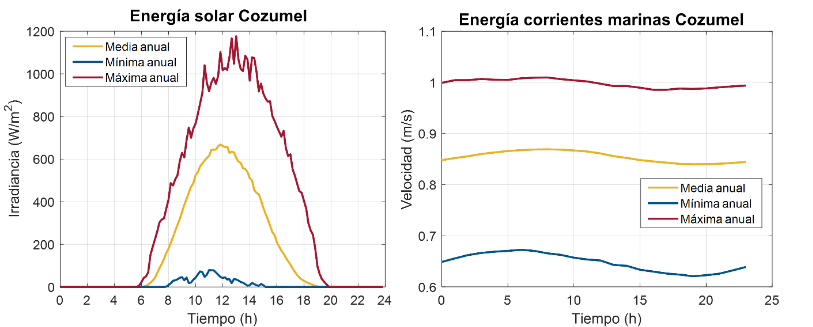
Figure 3. Solar and ocean current energy potential in Cozumel, Mexico [10].
A coastal home can consume around 7.5 kWh of electricity per day [12, 13], although this consumption can vary depending on the size of the home and socioeconomic status. In Figure 6a, the blue line shows a home's energy demand profile, with a small peak around 6 to 8 a.m. and a larger peak between 8 and 9 p.m., when more electricity is used.
The orange and yellow lines represent the installed capacity required for a solar photovoltaic system and a tidal current system, respectively, to cover those 7.5 kWh per day. Solar energy requires a higher installed capacity, 2.1 kW, compared to tidal current energy, which only requires 0.46 kW, as solar energy is available for fewer hours per day. By combining both sources, as shown by the purple line, it is possible to cover greater demand and reduce the need for energy storage (see Figure 4).
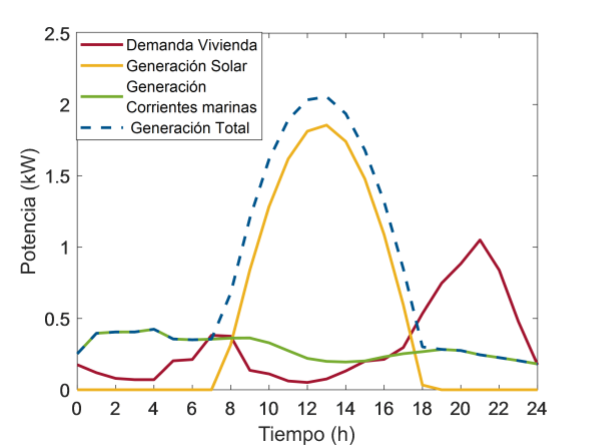
Figure 4. (a) Generation-consumption profile of a hybrid solar-ocean current system, with an installed capacity of 2.1 kW of photovoltaic solar panels and 0.46 kW of an ocean current turbine.
By combining solar energy with ocean current energy, both daily and seasonal fluctuations can be mitigated. By hybridizing the sources 50%, i.e., covering 50% of the electricity demand with solar energy and the other 50% with ocean current energy, 1.75 kWh/day of energy storage is required. This represents a 55% reduction compared to the storage required using only solar energy (see Figure 5).
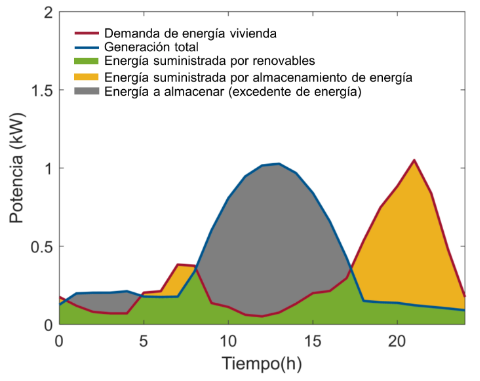
Figure 5. Generation-consumption profile, 50% hybridization of the hybrid solar-ocean current system.
When comparing different levels of hybridization between solar and ocean current energy, it was found that, although ocean current energy requires less daily storage, it requires a greater amount of seasonal storage due to greater variations in electricity generation (8% of the year does not cover daily demand) compared to solar energy (which does not cover 9% of daily demand throughout the year). With 60% hybridization, less seasonal storage is required, highlighting the importance of combining these energies (see Figure 6).
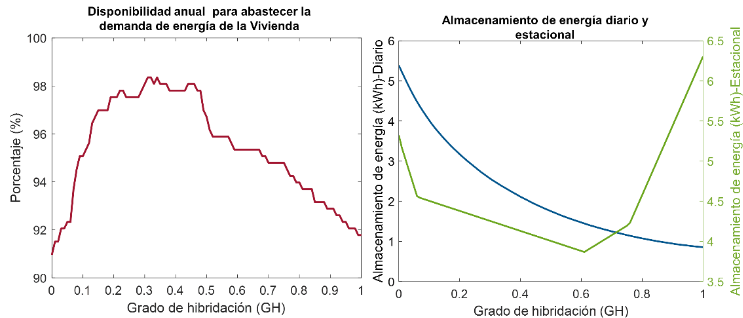
Figure 6. Annual availability to meet the household's energy demand and daily and seasonal storage capacity of a solar-ocean current system with different degrees of hybridization.
3. Energy Storage for Homes and Microgrids
Batteries are the most common and well-known energy storage technology (EST) due to factors such as their maturity—developed by Alessandro Volta over 200 years ago—their versatility, cost, and the different chemistries available, such as lead-acid and lithium-ion batteries. However, other storage technologies have also gained relevance due to their viability in different applications, such as pumped hydro storage (PHS), compressed air energy storage (CAES), flow batteries, flywheels, supercapacitors, and hydrogen, among others. Each of these energy storage technologies has advantages and disadvantages that can be evaluated according to criteria such as storage capacity, response time, lifetime, life cycle, efficiency, cost, power, energy density, and power rating, among others (see Table 1) [14,15].
Table 1. Comparison of different energy storage technologies based on different criteria.
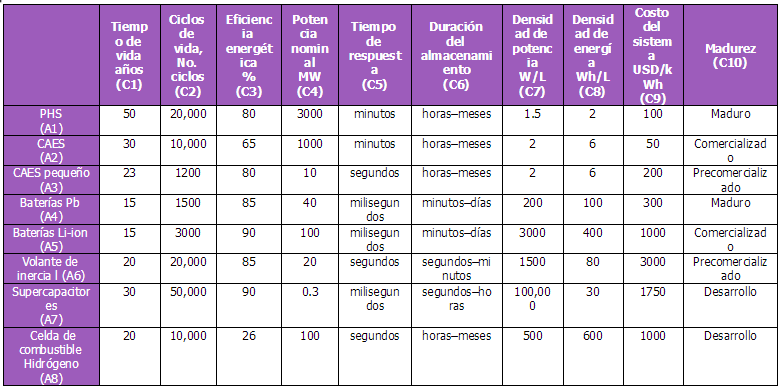
Batteries have been the most widely used EST in storage applications for homes or microgrids, thanks to their extensive development, versatility, and cost. However, options such as hydrogen have gained relevance, especially for long-term storage (weeks or months), where batteries can self-discharge and other technologies may be too large for low-power applications such as pumped hydro storage. Technologies such as CAES or PHS have become attractive for high-power electrical systems in the megawatt (MW) range.
The suitability of different energy storage technologies (ESTs) varies depending on the type of application. For electric vehicles, batteries are the most suitable due to their high power and energy density, which allows for lower weight and size compared to other technologies. Hydrogen, meanwhile, is an option that has gained interest in heavy-duty transport given the required autonomy time (longer distances) and greater power.
In the case of hybrid residential systems or microgrids, storage may be required to handle hourly, daily, monthly, or seasonal fluctuations, and even very brief fluctuations on the scale of seconds to minutes.
By evaluating all criteria and weighing their importance for these applications using multi-criteria methods, the most appropriate EAR can be determined. For energy storage that must handle daily fluctuations, the most critical factors are response time, followed by the number of cycles and efficiency. For seasonal fluctuations, storage duration is paramount, followed by response time and rated power, especially in low-power systems. Supercapacitors are best suited for regulation of less than one minute, lithium-ion batteries are ideal for hourly and daily fluctuations, while hydrogen storage is the most attractive option for long periods, such as monthly or seasonal.
Table 2. Comparison of the technical feasibility of different energy storage technologies for residential electricity supply.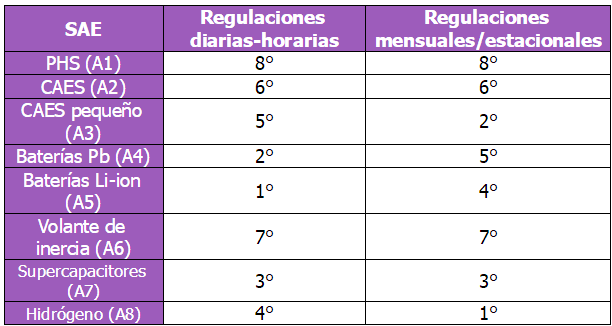
It is important to note that the need for energy storage will depend not only on the generation nature of the renewable energy source, but also on the desired energy surpluses. For example, geothermal energy and some forms of marine energy, such as thermal gradient or saline energy, can provide constant electricity generation; however, it may be profitable to store unused energy surpluses to sell at different time periods than their generation.
References
[1] García-Ochoa R, Graizbord B. Caracterización espacial de la pobreza energética en México. Un análisis a escala subnacional. Econ Soc y Territ 2016;16:289–337.
[2] CFE. Historia de la CFE. Com Fed Electr 2016. https://www.cfe.mx/nuestraempresa/pages/historia.aspx (accessed August 20, 2022).
[3] Dugan RC, McDermott TE. Distributed generation. IEEE Ind Appl Mag 2002;8:19–25. https://doi.org/10.1109/2943.985677.
[4] Hatziargyriou N, Asano H, Iravani R, Marnay C. Microgrids. IEEE Power Energy Mag 2007;5:78–94. https://doi.org/10.1109/MPAE.2007.376583.
[5] Bajpai P, Dash V. Hybrid renewable energy systems for power generation in stand-alone applications: A review. Renew Sustain Energy Rev 2012;16:2926–39. https://doi.org/10.1016/j.rser.2012.02.009.
[6] Cebulla F, Naegler T, Pohl M. Electrical energy storage in highly renewable European energy systems: Capacity requirements, spatial distribution, and storage dispatch. J Energy Storage 2017;14:211–23. https://doi.org/10.1016/j.est.2017.10.004.
[7] Uihlein A, Magagna D. Wave and tidal current energy - A review of the current state of research beyond technology. Renew Sustain Energy Rev 2016;58:1070–81. https://doi.org/10.1016/j.rser.2015.12.284.
[8] IRENA. Renewable Energy Prospects: Mexico, REmap 2030 analysis. Abu Dhabi: 2015.
[9] Hernández-Fontes J V., Felix A, Mendoza E, Cueto YR, Silva R. On the marine energy resources of Mexico. J Mar Sci Eng 2019;7. https://doi.org/10.3390/jmse7060191.
[10] Olmedo-González J, Ramos-Sánchez G, Garduño-Ruiz EP, González-Huerta R de G. Analysis of Stand-Alone Photovoltaic—Marine Current Hybrid System and the Influence on Daily and Seasonal Energy Storage. Energies 2022;15:1–21. https://doi.org/10.3390/en15020468.
[11] EERE. Should I Get Battery Storage for My Solar Energy System? | Department of Energy 2021. https://www.energy.gov/eere/solar/articles/should-i-get-battery-storage… (accessed August 20, 2022).
[12] Cruz González G, Alejandro M, Saldívar D. El consumo de energía eléctrica en los hogares de México por nivel de ingresos, 2012. Tiempo Económico 2015;X:43–56.
[13] Taufiqul M, T. Oo AM, Shawkat Ali ABM. Estimation of Energy Storage and Its Feasibility Analysis. In: Zobaa AF, editor. Energy Storage - Technol. Appl., IntechOpen; 2013, p. 41–78. https://doi.org/10.5772/52218.
[14] Guney MS, Tepe Y. Classification and assessment of energy storage systems. Renew Sustain Energy Rev 2017;75:1187–97. https://doi.org/10.1016/j.rser.2016.11.102.
[15] Luo X, Wang J, Dooner M, Clarke J. Overview of current development in electrical energy storage technologies and the application potential in power system operation. Appl Energy 2015;137:511–36. https://doi.org/10.1016/j.apenergy.2014.09.081.



